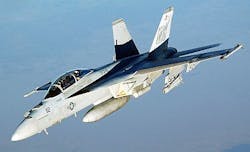Raytheon to build EW and radar systems for Navy fighter-bombers in contracts worth $122.5 million
PATUXENT RIVER NAS, Md., 4 March 2012. U.S. Navy aviation experts needed radar warning receivers, electronic warfare (EW) signal processors, and active electronically scanned array (AESA) radar systems for the Navy's F/A-18 Hornet carrier-based jet fighter-bomber. They found their solution from two divisions of the Raytheon Co. Space and Airborne Systems segment.
Officials of the Naval Air Systems Command at Patuxent River Naval Air Station, Md., last week awarded Raytheon two contract modifications collectively worth $122.5 million for 89 AN/ALR-67(V)3 radar warning receivers, nine countermeasure signal processor weapons replacement assemblies, and 16 AN/APG-79 AESA radar systems.
Raytheon Space and Airborne Systems in Goleta, Calif., will build the radar warning receivers and electronic warfare signal processors, while Raytheon Space and Airborne Systems in El Segundo, Calif., will build the AESA radars. The Goleta segment will do the work under terms of a $77.28 million contract modification, and the El Segundo segment will do the work under terms of a $45.3 million contract.
The AN/ALR-67(V)3 radar warning receiver enhances F/A-18 pilot situational awareness by identifying, locating, and ranking the potential deadliness of enemy and friendly radar emitters. The system also controls the F/A-18's electronic warfare data bus, and interfaces with the aircraft's electronic warfare systems, onboard radar, airborne mission computer, and onboard weapons.
The AN/APG-79 AESA radar is designed to replace the F/A-18's APG-73 radar, and enhances the pilot's air-to-air detection and track range, as well as the pilot's ability to attack ground targets. The new radar has a longer launch range for standoff weapons than the older APG-73 radar, and makes best use of the aircraft’s weapon systems.
Raytheon will do the radar warning receiver work in Forest, Miss.; Lansdale, Pa.; Goleta, Calif.; Chatsworth, Calif.; San Diego; Sydney, Australia; Milwaukie, Ore.; and McKinney, Texas, and should be finished by 2014. The company will do the AESA radar work in Forest, Miss.; Dallas; El Segundo, Calif.; and Andover, Mass., and should be finished by late 2014.
For more information contact Raytheon Space and Airborne Systems online at www.raytheon.com/businesses/rsas, or Naval Air Systems Command at www.navair.navy.mil.

